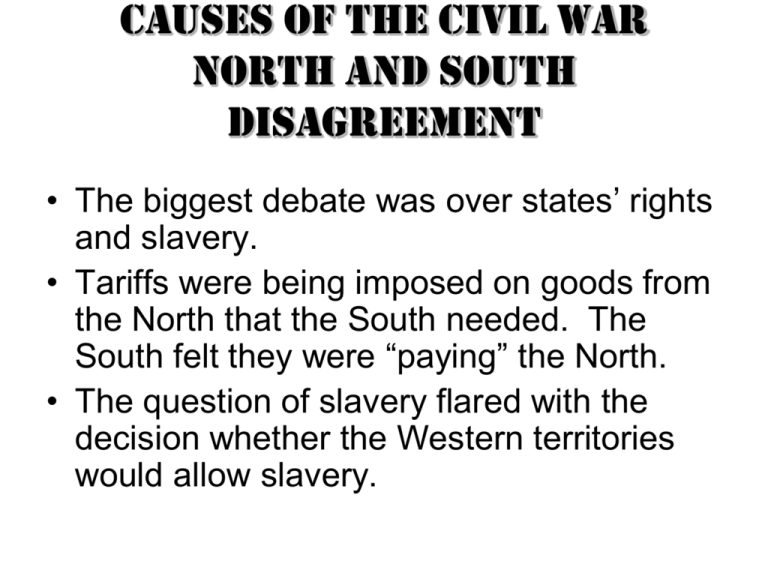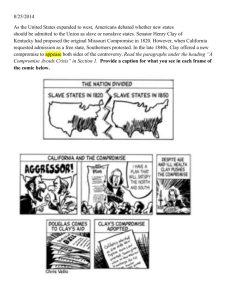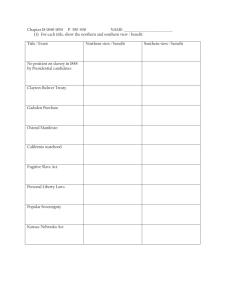Missouri Compromise
advertisement

Causes of the Civil War North and South Disagreement • The biggest debate was over states’ rights and slavery. • Tariffs were being imposed on goods from the North that the South needed. The South felt they were “paying” the North. • The question of slavery flared with the decision whether the Western territories would allow slavery. MISSOURI COMPROMISE Missouri Compromise • Issue – Missouri ready for statehood – Wants to allow slavery within state – Already have 11 free states and 11 slave states • Division – Allowing slavery in Missouri would upset balance of power in Senate – What’s so important about that? • OUTCOME? • Missouri – slave state • Maine – free state • Imaginary line drawn at southern border of Missouri – slavery banned north of the line • So that resolves the issue for future states in this territory - RIGHT? • (hint: Kansas-Nebraska Act) Wilmot Proviso • Would have banned slavery in any territory to be acquired from the Mexican War (the area known as the Mexican Cession) • Wilmot envisioned California as a place where free whites could work without the competition of slave labor. Since the north was more populous and had more Representatives in the House, the Wilmot Proviso passed there BUT… • Laws require the approval of both houses of Congress. The Senate, equally divided between free states and slave states could not muster the majority necessary for approval Why it would have been a big deal. Even though it failed – tensions were getting stronger! AND it really started to get ugly when they found gold in California (not on your paper) • Issue – California ready to apply for statehood in 1850 • Division – Again would upset balance of power • Now have 15 free and 15 slave states – North thought it should be FREE due to Missouri Compromise line Outcome of California Statehood • John Calhoun again threatened SECESSION • Henry Clay proposed COMPROMISE of 1850 Compromise of 1850 Compromise of 1850 • California – Free State • New Mexico and Utah territory will decide by popular sovereignty Compromise of 1850 • Created Division: • VERY FAVORABLE TO NORTH by allowing California to be a free state • Remember the House of Representatives is based on ??? • Compromise had to include something for Southern states That something… Fugitive Slave Act • Issue: • required ALL citizens to assist in the recovery of fugitive slaves. • denied a fugitive's right to a jury trial. Cases were handled by special commissioners – • Commissioners would be paid $5 if an alleged fugitive were released and $10 if he or she were sent away with the claimant. THE FUGITIVE SLAVE ACT WAS DESIGNED TO RETURN AS MANY RUNAWAY SLAVES TO THE SOUTH AS POSSIBLE. THE LAW MADE IT ILLEGAL TO HELP RUNAWAY SLAVES ESCAPE AND OFFERED REWARDS FOR THE SLAVE CATCHERS AND THE JUDGES. MANY RUNAWAYS WENT TO CANADA WHICH HAD NO FUGITIVE SLAVE LAWS. Fugitive Slave Act • Refusal to follow law could result in $1000 fine and jail time Underground Railroad Conductors Harriet Tubman Frederick Douglass Routes to Canada to escape Fugitive Slave Act Uncle Tom’s Cabin by Harriet Beecher Stowe Why would Abraham Lincoln later say to her “so you’re the little lady that started this big war” Road to Secession – Uncle Tom’s Cabin • Main issue – – book of fiction showing the evils of slavery • How division created – Brought awareness of evils of slavery to the North. – Angered the South • Outcome – Northern criticism over slavery threatened Southerners way of life Kansas Nebraska Act • Issue Kansas Nebraska Act – Proposal to allow new territories of Kansas and Nebraska to decide slavery issue by popular sovereignty • Division – North thought the issue had been settled by Missouri Compromise • OUTCOME – Territory became open to slavery – Violence known as Bleeding Kansas Kansas-Nebraska Act, 1854 John Brown‘s raid • In 1859, John Brown, a radical violent abolitionist attacked the federal arsenal in Harper‘s Ferry, Virginia with ca. 20 followers. • He wanted to seize weapons for a general slave insurrection. • After two days fighting he was defeated, tried and sentenced to death in Virginia . • In the South, Brown was considered a terrorist who deserved death. • In the North, many abolitionists supported him. Others decried the violence but felt sympathetic. heroic painting of John Brown Dred Scott One of the saddest events in US History WHY? 1857 Dred Scott v.Sanford Supreme Court Case • DRED SCOTT WAS A SLAVE WHO WORKED FOR HIS MASTER IN A FREE TERRITORY. WHEN THE MASTER DIED, SCOTT BECAME THE PROPERTY OF THE MASTER’S FAMILY BUT SCOTT CHALLENGED THIS IN COURT STRESSING THAT HE HAD WORKED IN A FREE TERRITORY AND HAD THE RIGHT TO NOW BE FREE. THE COURT RULING --DRED SCOTT v SANFORD 1854: DRED SCOTT WAS PROPERTY AND BELONGED TO THE MASTER’S FAMILY. 1. DRED SCOTT WAS A SLAVE HAD THEREFORE HAD NOT RIGHT TO SUE ANYONE IN COURT. DRED SCOTT LOST HIS CASE BUT SUPPORTERS BOUGHT HIM SO HE COULD FINALLY BE FREE! 2. SLAVERY BANS IN THE NEW TERRITORIES WERE BASICALLY ILLEGAL BECAUSE OF ABSOLUTE PROPERTY RIGHTS OF THE MASTER. Dred Scott case • ISSUE: – Slave sued for freedom after living in territory that banned slavery • DIVISION: – Questioned if slaves had rights • OUTCOME: – Supreme Court ruled slaves were property – Property rights protected by 5th amendment – THEREFORE any laws limiting slavery WERE UNCONSTITUTIONAL The Election of 1860, Secession, and the War Begins Election of 1860 • ISSUE: – Lincoln won the election with no support from the south • DIVISION: – The south feared he would try to abolish slavery and had the political power to do so • OUTCOME: – Southern states SECEDED and formed the Confederacy







